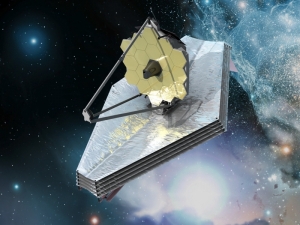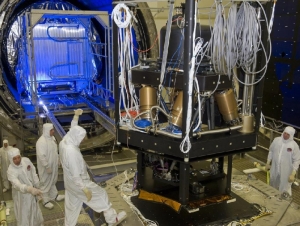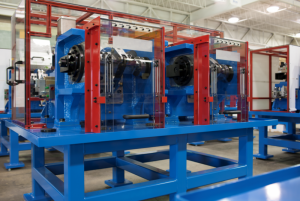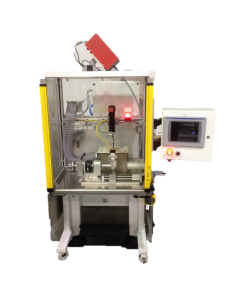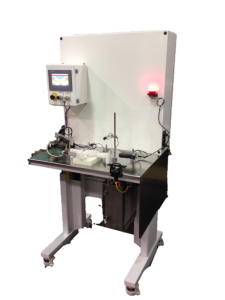Dual Precision Link Conveyor System
Micro built this fully automated turnkey system with two precision link conveyors with independent controls systems. The dual conveyors allow each side of the machine to run independently. Each side of the machine can be serviced independently and different products can be run on either side at the same time. The conveyors utilize a cam driven indexer with attached pallets. Parts are bowl fed, and placed in pallets, processed, vision-inspected, auto-bagged and labeled through twenty stations. The HMI is set on a rail type system allowing it to be positioned at the point of use for each station.
Center of Curvature Optical Assembly
The James Webb Space Telescope (JWST) is the super-sized successor to the Hubble Telescope. Slated for launch in 2018, the JWST will peer back in time and provide never before seen images of our universe's stars and galaxies.
JWST will travel 940,000 miles, while being exposed to temperatures of -387°. Three months after its departure, it will reach a balance point between the gravitational pulls of our Sun and Earth. It is of the utmost importance that this multi-billion dollar piece of science is calibrated correctly – which is where ITT Exelis and Micro step in.
A device called the Center of Curvature Optical Assembly, or COCOA is the primary piece of measuring equipment used to calibrate the accuracy and performance of the JWST. It will be responsible for revealing height differences and aligning the 18 beryllium mirror segments that make up the 21 foot mirror array of JWST.
The COCOA device was built and assembled at Micro's facility in Rochester, New York, alongside ITT Exelis and NASA. Being the vendor chosen to help build the next generation Space Telescope has brought Micro great pride, and we are honored to work with such respected aerospace organizations.
For more information on how NASA uses COCOA to test the JWST, please see the video below:
Hydraulic Actuator Tester
Micro built 18 of these test units for hydraulic actuators and shipped them around the world. The units were for a "build-to-print" project which was built to aerospace standards. Micro provided technical support for manufacturability and insights of the local supply-base to provide a more rapid delivery.
Table-top Leak Check Device
The station is semi-automatic with the operator manually placing the part into the fixture and a Cincinnati Leak test unit performing a mass flow test on the product. The fixture processes three different products and is mounted to a base plate which can be placed on a table. Micro provided an Allen-Bradley based control system that will consist of a CompactLogix L24ER PLC and a PanelView Plus6 1000 Color Touch Screen for machine control. A safety circuit comprising of an E-Stop pushbutton and safety relay was installed to prevent the operator from contacting any potentially hazardous tooling and components.
Adhesive Dispensing Stations
The stations are semi-automatic with the operator manually loading and unloading the part and the station automatically dispensing Loctite and UV to cure it. The fixturing/tooling can be mounted to a common base plate for mounting to a table or designed as a complete station. Guarding was fabricated from aluminum extrusion framework with Lexan panels. Safety interlocked access doors or a light curtain can be used for operator access.
Lean Cell Inspection Stations
These systems provide an automated platform for high-resolution inspection of medical devices. Components are manually loaded into custom designed tooling nests where the operator selects viewing screens and options via the PLC touch panel. The digital cameras automatically verify the part number and perform the product inspection.
High Mix/Low Volume Packaging Machine
The turn-key automated system below was designed and built by Micro for labeling, product order sorting, and manual cartoning for a medical device manufacturer. Micro supplied all the necessary engineering, managerial, fabrication, assembly, testing, and quality control skill sets to provide the completed system and meet all URS requirements (including part handling, data tracking, printing, database communication and Allen Bradley ControLogix automation). Bar codes are read by the system and used to print strip labels arrange Purchase Orders for labeling and manual cartooning, and arrange Shipping Orders -- all according to the customer data base. The information collected from the incoming product and printed cartons is saved by the system for historical purposes.
Robotic Applications
Micro worked with a world-class manufacturer to use robotic motion on a non-destructive testing system. The system requires the Fanuc robot to move the end of arm tooling around all exterior surfaces of a large manufactured part. A perimeter fence with interlock switches, two laser scanners, and warning lights were installed to ensure operator safety. A custom NEMA 12 electrical enclosure was supplied to house all required controls components, power supplies, and air conditioning required for the application.

